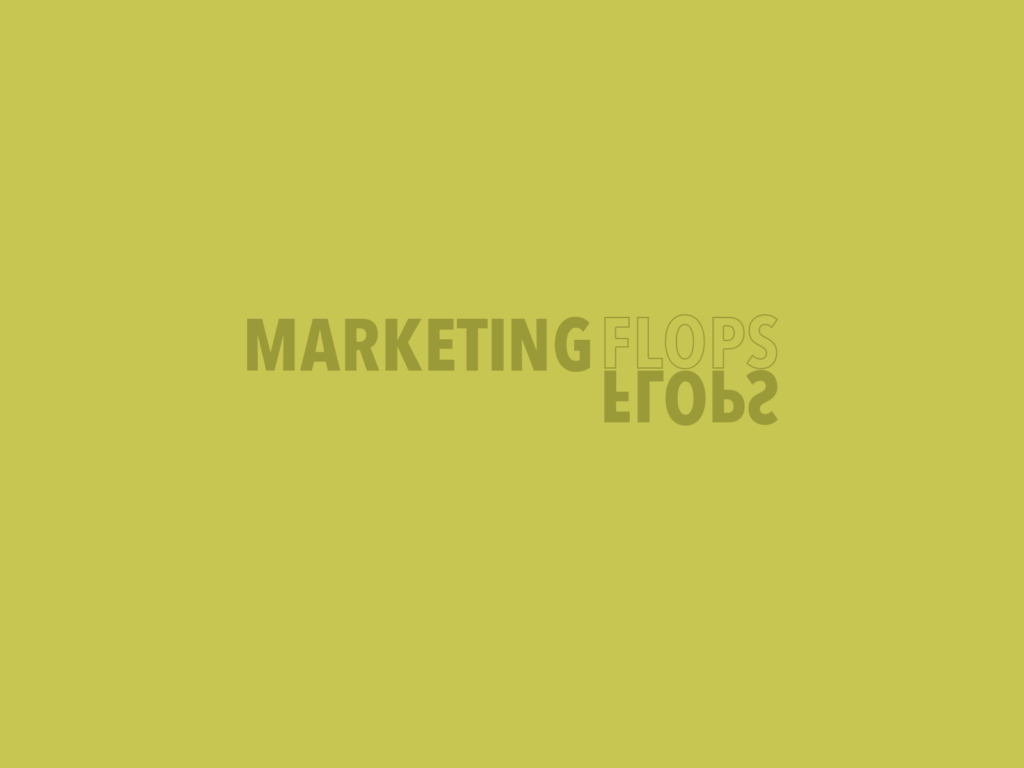Marketing Flops; you’ve seen them whether you recognized it or not. They are all around! We came up a few what-not-to-do’s so you don’t have to, from brands that already did it.
Remember that time Burger King introduced a new, lower-calorie french fry that offered 30% fewer calories and 40% less fat? Same big taste guaranteed? Yeah, we didn’t either. If you did remember, kudos to you because “Satis-fries” lasted less than one year on the Burger King menu in 2013 (which somehow was almost ten years ago.)
The “Satis-fry” used a less porous batter, so there was less oil and fat in the fry, and that’s honestly pretty genius. It could have been a long-lasting product if it had been properly marketed. Many people would have been interested in cutting calories while enjoying junk food (i.e.-low cal ice cream pints.). Satis-fries should have been a commercial hit, not a dud. Customers did not connect with the product or understand it. This is exactly why marketing matters.
Marketing blunders are easy enough to make, but they are just as easy to avoid when you hire experts. For your benefit and our amusement, we researched some famous marketing flops. Each of these five errors costs a lot of money, time, and resources. Don’t make the same mistakes as the folks below!
- Four Loko: Not all publicity is good publicity.
Four Loko’s unofficial slogan was “horny, hyper, and happy.” The brand’s name was based on (the audacity) of their four main ingredients: alcohol, caffeine, taurine, and guarana. This recipe was disastrous. It was a dangerous combination of stimulants and depressants marketed to young people using numerous celebrity endorsements. What could go wrong? After more than a dozen hospitalizations and multiple deaths were attributed to the drink, the company earned a negative reputation. Consumers realized the slogan should have been something more like “heinous, hazardous, and harmful.” Colleges banned it. New York state and the company agreed they would no longer ship their product over state lines. Lawsuits were being threatened left and right.
Selling an edgy image is fine; being legitimately dangerous is not. Even though the drink captured the hearts and minds of the average American college Freshman, it wasn’t enough to save them. The company went from $100 million a year in sales to over $30 million in products they could no longer sell. Slowly, the product has found its footing again in the market. It has yet to see the success it received back in 2010, and because of bad reputation management, that is likely to remain an uphill battle. And when you do get bad press, you need people to help manage public relations and bring back some good press. This is where public relations experts come in! They already have connections with journalists, and a good marketing team knows how to spin reputation. It’s all about the rebrand sometimes.
- Colgate Kitchen Entrees: Stay in your brand’s lane.
Colgate, a company best known for toothpaste, decided to break into the frozen entree market. Maybe they thought there was a market of people that wanted cavity protection and dried crabmeat from the same brand. In their defense, it was a very tempting market to break into with estimated revenues of $4 billion. One of the more infamous in this launch was Colgate’s Beef Lasagne To date, the actual product hasn’t been proven to exist! The documented product launch was in Madison, Wisconsin, and instead of lasagne it was dried chicken and crab meat, yum…It’s hard to say if the lasagne ever existed because Colgate has scrubbed all records of their frozen entree endeavors from company history and publicly refutes it.

Brand extension can be a lucrative choice. Think about Reese’s Puff cereal. What started as a chocolate and peanut butter cup quickly transitioned into the breakfast cereal market because kids already love their product, and parents already trust their brand. Another company that achieved success is the cross-over of Harley-Davidson from motorcycles to apparel. This brand extension worked because the brand is a cult favorite: synonymous with a very loyal customer base that likes to be associated with the brand. The logo itself is a signifier, and that’s why merchandising worked.
In the case of brand extension for Colgate, it was more of an example of brand over-extension. It is wise to be very self-aware about brand strengths, weaknesses, and greatest appeals. Colgate was trusted with hygienic personal care products, and people associate that with a bathroom, and you know what people don’t want to think about as they eat dried crabmeat? The bathroom. Colgate could have saved themselves a lot of money if they had closed this concept at the pitch, which would have happened with a good marketing agency. Alas. At least we can laugh at it now!
- Bic for Her: Offending your base is not profitable.
How does one make pens and stationary offensive? You don’t have to do much work to get the answer because Bic already did the leg work. The year was 2012 when someone at Bic thought, “How can we celebrate International Women’s Day?” Their answer: a campaign with the slogan, “Look like a girl, act like a lady, think like a man, and work like a boss.” The pens were marketed as an accessory. The colors were pink and purple. Associated tags on the product were “small lady hands,” “soft-brained women,” and “delicate flowers.” People took to Twitter and news outlets in a rage about the campaign. In short, the internet did its thing.
 Gendering products can increase profits. Disposable razors, children’s toys, and perfumes/colognes know this all too well. However, the focus has to be customer-centric. Otherwise, it feels arbitrary at best and offensive at worst. This concept goes for anything that could be insensitive to marginalized communities, not just women. The same logic goes for racial insensitivity, homophobic marketing, or ableism. We live in a time where scrutiny for social missteps is at an all-time high, and no one knows everything about every community. But most unintentional insensitivity can be avoided when you work with a diverse marketing agency, like us at BKN. We are an LGBTBE certified minority business through the National Gay and Lesbian Chamber of Commerce (NGLCC). We aim to be allies to all minority communities, and our work reflects that.
Gendering products can increase profits. Disposable razors, children’s toys, and perfumes/colognes know this all too well. However, the focus has to be customer-centric. Otherwise, it feels arbitrary at best and offensive at worst. This concept goes for anything that could be insensitive to marginalized communities, not just women. The same logic goes for racial insensitivity, homophobic marketing, or ableism. We live in a time where scrutiny for social missteps is at an all-time high, and no one knows everything about every community. But most unintentional insensitivity can be avoided when you work with a diverse marketing agency, like us at BKN. We are an LGBTBE certified minority business through the National Gay and Lesbian Chamber of Commerce (NGLCC). We aim to be allies to all minority communities, and our work reflects that.
- Barnes & Noble’s Nook: Communication is critical.
Nooks entered the market as a viable competitor to Amazon’s Kindle and Apple’s iPad as an electronic book reader. Nook’s first generation has since been discontinued and the future for the electronic reader is anything but promising. There are numerous reasons this product struggles, from lousy timing to bad pricing. But let’s focus on one consistent complaint: customers feel out of the loop. Nook has switched manufacturers, changed their downloading software capabilities, changed their memory storage, and users lost their catalog of e-books in this mix. There were just too many changes in such a short time. Many Nook-related changes were made with little or no communication to their users. This left their base in the dark.
Frustrated customers tried reaching out to customer service with disappointing results. Poor communication leads to distrust with the product, and then guess what? People take their business elsewhere. This is another mistake that can be circumnavigated, but it’s no easy task to tackle on your own. Press releases, social media, responding to customer reviews— all of these things can be managed by quality marketing agencies. If you’re already running a business and managing employees, adding customer communication is not just hard. It is impossible.
- New Coke: Don’t try to fix what isn’t broken.
This is the granddaddy of all marketing mistakes. New Coke is what were you thinking of first, wasn’t it? For those who missed this debacle, Coca Cola, the extremely popular brand, with some of the most loyal consumers on the market, changed its recipe. Before the launch, there was a little-known feud between Pepsi and Coke known as the “cola wars.” Coke decided to change its formula and do a relaunch as New Coke to get ahead in this alleged war. The backlash was swift. People boycotted. The product was dropped within weeks, and then, ironically, classic Coke sales boomed beyond anything the brand had seen in years.

There is speculation surrounding this marketing “fail,” and the speculation is that marketers at Coke are geniuses who anticipated the outrage and capitalized on it. Donald Keough, the president of Coke at the time, responded to this by saying, “We’re not that dumb, and we’re not that smart.” The truth is, they got lucky. And they moved at precisely the right speed. The public was still invested enough in the product to return bounce back. Maybe one of these things is not like the others.
Because the New Coke, if we indulge in conspiracy theories for a moment, was pretty dang genius. Not scandalous enough for serious outrage, but strange enough to get attention. It renewed people’s love of Coke’s original taste, and it even ended a war. Think about it—the company managed to increase its profits with a marketing dud. If you’re going to fail, fail so spectacularly that you gain revenue. Powerful stuff. Truly inspirational.
In summation, marketing mistakes can be incredibly hard or impossible to recover from. The good news is, there are people who do this sort of thing for a living so you don’t have to. When it comes to marketing, trust professional marketers! When marketing yourself, you can make a million more mistakes as a business or individual, way more than we could explain in five lessons. Let the pros at BKN Creative be your guide. Before you go, remember— Not all publicity is good publicity. Stay in your brand’s lane. Offending your market is not profitable. Communication is key. And don’t try to fix what isn’t broken.



